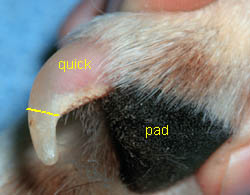 Most dogs do not like having their toenails trimmed. If you start trimming them when your dog is young he will get used to it and may even let you trim with little resistance.
Most dogs do not like having their toenails trimmed. If you start trimming them when your dog is young he will get used to it and may even let you trim with little resistance.
One method to restrain the dog is to place her/him on a table. Stand on the side of the table opposite to the claws you are trimming. Drape your arms and upper body over the dog. When trimming the front claws, keep your left forearm over the neck to keep the dog from lifting its head. Hold the paw in your left hand and hold the trimmer in your right hand. If the dog tries to stand, lean your upper body over his/her shoulders to prevent him/her from rising.
There are several styles of nail trimmers, including the guillotine type and the scissors type. The guillotine type is the easiest to use with dogs. The guillotine type have a stationary ring in which the nail is placed, with a cutting blade that moves up to slice off the nail when the handles are squeezed.
When trimming the nail, look for the area called the “quick”, which will be darker in color because it circulates blood to that area. You’ll want to cut no closer than approximately 2 millimeters of the quick or you’ll cause it to bleed and it will be painful to the dog. With dark color nails you may want to clip in smaller increments to be sure you are not cutting too short.
The scissors-type is used to trim a toenail that is so long that it is curling in a circle. Long claws can grow into the toe-pad. This most often happens to dew claws, the claw on the inner side of the paw. Dew claws do not touch the ground so they are not worn down as the dog walks. The dew claw is attached to the leg by loose skin. The dew claw can usually be bent away from the leg so that you can fit a guillotine type trimmer over the tip of the dew claw.
The handles of the trimmer can be held pointing toward the floor (cutting the nail from bottom to top) or the handles of the trimmer can be held pointed towards the ceiling (cutting the nail from top to bottom); which ever is more comfortable in your hands.
The tip of the nail is placed in the stationary ring in the trimmer with the clipper perpendicular to the nail (cutting either top to bottom or bottom to top). If the trimmer is placed parallel to the nail (cutting from side to side), the nail is crushed and may splinter.
The cutting blade should be facing you, NOT the dog. The screws on the handle of the trimmer should be facing the dog. If you turn the trimmer around with the screws toward you, the cutting blade is cutting closer to the quick than if the trimmer is held with the cutting blade toward you. You are less likely to cut into the quick if the cutting blade faces you. The handles of the trimmer are squeezed to advance the cutting blade through the nail.
Light colored claws can be trimmed with one cut on each nail. Cut dark colored claws in several small cuts to reduce the chance of cutting into the quick.
If the toenail is cut too short, you can use a styptic pencil containing silver nitrate to stop blood flow, although many animals object to the styptic pencil as much, or more, than toenail cutting. The black end of the stick is held to the bleeding nail and gently rotated until bleeding stops.
Even without any treatment the nail should stop bleeding in about 5 minutes or less.
If toenail trimming is not something you want to attempt yourself, give us a call and we can take care of it with a simple office visit at All Around Feed & Vet.
Source: Washington State University College of Veterinary Medicine